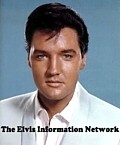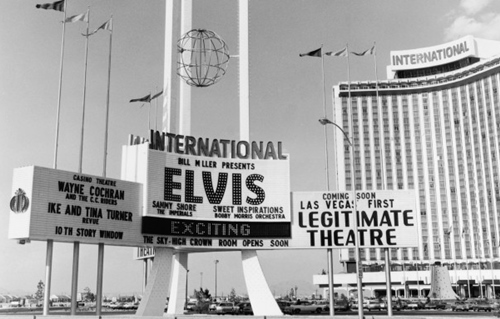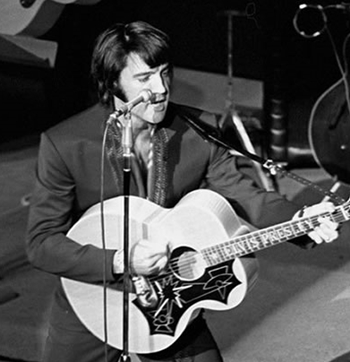 |
 |

Elvis in Vegas: How the King Reinvented the Las Vegas Show, Richard Zoglin, Simon & Schuster, USA, 2019, 297 pages, Illustrated, ISBN-13: 978-1501151194.
Elvis in Vegas is available now - it has been released in hardback, Kindle/ebook, audiobook, and audio cd formats Richard Zoglin’s new book, Elvis in Vegas: How the King Reinvented the Las Vegas Show, is one of those of books that offers much more than its title suggests. Zoglin, whose earlier books on stand-up comedy in America and the legendary Bob Hope, were both critically acclaimed, is already garnering acclaim for his new book in respected quarters. This is hardly surprising given Zogler's pedigree as a long time senior editor and theater critic with Time magazine. While the author's initial idea was to write a history of Sin City, he realised that Elvis’ initial Vegas stint in 1956 and his triumphant return in 1969 perfectly bookend the golden era in Vegas history, with Elvis’ show in 1969 a landmark event which rescued a floundering Vegas and redefined what a Vegas show would be.
What Zoglin has produced with Elvis in Vegas: How the King Reinvented the Las Vegas Show is a fascinating history of Vegas as entertainment capital, its colorful stars of yesteryear, and a seminal account of how one artist, in 1969, redefined its future.
The evolution of Vegas from its beginnings as a missionary outpost, later bustling music halls/saloons and houses of prostitution, through its period of mob run hotels where the Rat Pack reigned, to a corporately controlled town where Elvis broke all records, makes for great and eye-opening reading:
Las Vegas has a wonderfully storied past and Zoglin robustly captures the color, drama and spectacle for the reader to marvel at and savor. The author's important exploration of segregation and racism in Vegas may unsettle some readers while other accounts, such as the acts appearing at the Lido de Paris will elicit a much different response:
The individual characters, from the Rat Pack and Wayne Newton to Tom Jones and Barbra Streisand, are legendary. Be it Sophie Tucker, the "Last of the Red Hot Mamas" or mobster Benjamin Siegel (better known by his nickname "Bugsy"), who by one account came up with the idea to make the casino (rather than the hotel) the hub of the action and dispose of the old world decor usually embraced by Vegas hotel operators and replace it with an LA-inspired Sunbelt-modern design, Elvis in Vegas is a delightfully entertaining and illuminating read. Zoglin's account of legendary Vegas comedian, Shecky Greene, who supported Elvis during his failed 1956 Vegas appearances, will be welcomed by many readers. The day "Beatlemania" took over Vegas - the Beatles' two performances at the Las Vegas Convention Center in August 1964 are also covered. Zoglin's record of Elvis' triumphant return to Vegas in 1969 is rich in detail and emotion:
That Elvis received what surely must have been previously unheard of, a standing ovation at his press conference after his opening night "by invitation only" show on July 31, 1969, is testament to the incredible power and impact he had in August 1969.
(Above photo by Paul Gansky - see his story of seeing Elvis in concert in Las Vegas 1969 here)
A key theme underpinning Zoglin's story is that one must understand the back-story to Vegas in order to understand why Elvis was so important to the town when he returned there in 1969. In Richard Zoglin’s well considered world, Elvis '69 with his "non-conventional Vegas show", was a transformational moment which changed Vegas forever:
The author notes that incredibly, Elvis reinvented the Vegas show without having a show producer or director - Elvis was his own producer. He also details how important Colonel Tom Parker was in Elvis' Vegas success through his saturation marketing campaign.
Elvis’ influence was also not limited to redefining the "Vegas show", it went further with Zoglin observing:
While as suggested by its title, Elvis in Vegas: How Elvis Reinvented the Las Vegas Show, Zoglin's emphasis is on how Elvis transformed Vegas, he does not ignore Elvis’ decline, personally or as a performer. Neither does he sensationalise or dwell on the issue. Instead he offers a matter-of-fact account of how cracks started to appear from Elvis' August 1971 season, leaving it to the reader to reflect on what happened:
The author’s strengths are many, particularly his ability to source primary source information and the intellectual incisiveness he brings to explaining his story and placing each phase of Vegas’s evolution, including Elvis' influence, in its socio-political-cultural context. Zoglin also has that rare ability to bring his subject matter to life without having to resort to verbiage and overuse of flowery or rhetorical prose. His narrative exhibits a nice elan, flowing freely, and I found myself losing track of time as my mind was lost in the story. In combination, these elements set Elvis in Vegas well apart from and make it more intriguing than other books on the subject. Elvis in Vegas includes 23 pages of Notes (references) and a selected list of recordings (Live from Vegas). The photos section is in b&w and includes around 20 related Elvis images and an assortment of other Vegas related images. Verdict: Elvis in Vegas: How the King Reinvented the Las Vegas Show is an engrossing, fast paced history of Vegas with Elvis’ comeback and rock approach to staging his show "headlined" as a transformational point in the town's chequered history. Zoglin brings Vegas’ almost Jekyll and Hyde personality to life and does so with reverence and honesty, never shying away from the dissonance often at play. This is a richly textured book which fluidly examines its subjects in multi-dimensional fashion. As Richard Zoglin notes, ‘Las Vegas saved Elvis, at least for a little while. And Elvis showed Vegas its future’. Highly recommended.
|
|



